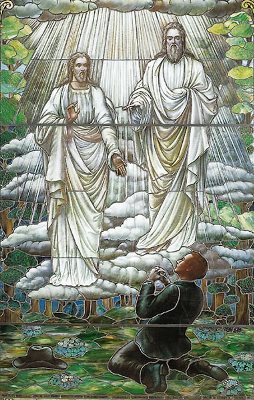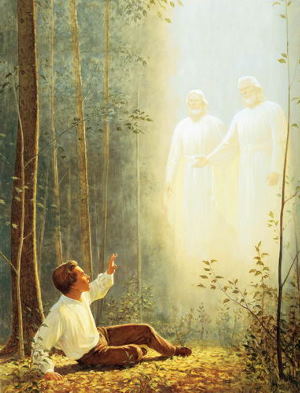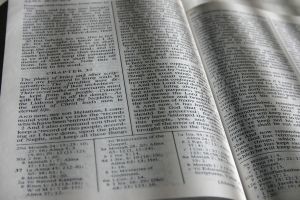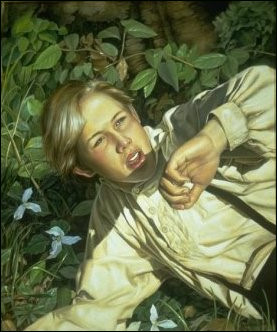|
The
Church tells us:
 "A
believing boy took one small step and prayed. A loving
Father in Heaven listened and responded. What has resulted
could rightfully be referred to as one giant leap for
mankind. All the towers ever built and all the spaceships
ever launched pale in comparison to Joseph Smith's first
vision. Though men fly higher and higher into the
heavens, they will not find God or see his face unless
they humble themselves, pray, and heed the truths revealed
through the Prophet of the Restoration (Joseph Smith)." "A
believing boy took one small step and prayed. A loving
Father in Heaven listened and responded. What has resulted
could rightfully be referred to as one giant leap for
mankind. All the towers ever built and all the spaceships
ever launched pale in comparison to Joseph Smith's first
vision. Though men fly higher and higher into the
heavens, they will not find God or see his face unless
they humble themselves, pray, and heed the truths revealed
through the Prophet of the Restoration (Joseph Smith)."
"Some have foolishly said, 'Take away Joseph Smith and
his prayer in the grove and the First Vision, and we can
accept your message.' Such people would have us bury the
treasure of saving truths already cited, and many more,
and turn our backs on the most important event that
has taken place in all world history from the day of Christ's
ministry to the glorious hour when the First Vision occurred."
- Elder Carlos E. Asay, "One Small Step for a Man;
One Giant Leap for Mankind," Ensign, May 1990, page 62
So
I have several questions about the First Vision Story:
1.
Why didn't Joseph Smith write the "official" version of
the First Vision?
In fact, the Joseph Smith History in the Pearl of Great
Price was written by a scribe, James Mulholland, and went
unpublished for years. There are earlier versions of the
First Vision story in Joseph Smith's own handwriting,
but they are not considered "official" and are relatively
ignored by the church.
2. If the official First Vision story was so important,
why did it go unpublished until 1842?
Smith supposedly had his vision in 1820. Yet it took over
seven private revisions and another 22 years to have it
first published.
3. If Jesus Christ and God the Father really told Joseph
Smith in 1820 that all churches were an abomination, then
why did he try joining the Methodist church in June of
1828?
Records show that in June of 1828, Joseph Smith applied
for membership in his wife's Methodist Church. He also
joined Methodist classes taught there. (The Amboy Journal,
Amboy, IL, details Smith's activity in the Methodist Church
in 1828. April 30, 1879 p. 1; May 21, 1879 p.1; June 11,
1879, p.1; July 2, 1879 p.1.)
4. If Joseph Smith saw God in 1820, why did he pray
in his room in 1823 to find out "if a Supreme being did
exist?"
In the first history of Mormonism from 1835 written under
Joseph Smith's direction, it says that the night of September
1823 Joseph Smith began praying in his bed to learn "the
all important information, if a Supreme being did exist,
to have an assurance that he was accepted of him."
(LDS periodical Messenger and Advocate, Kirtland,
Ohio, Feb. 1835) How could that possibly make
sense if Smith had already seen God face-to-face some
three years earlier in 1820?
See: http://www.irr.org/mit/first-vision/1834-35-account.html
5.
Why did Joseph Smith fail to mention his First Vision
when he first wrote a church history in 1835?
Joseph Smith and Oliver Cowdery wrote and published a
history of the church that supposedly covered all of the
important points related to its beginnings. However, Joseph
Smith records a different story than the "official" one
later published in 1842. In Joseph Smith's own 1835 published
history of the church, he says that his first spiritual
experience was in 1823 after a religious revival in Palmyra
that same year. Smith testified that he prayed while in
bed to discover if God existed when he was visited by
an angelic messenger (Moroni) that forgave him his sins.
Elements of this narrative are similar to the later "official"
version except the "official" version has different dates,
locations, visitors and purposes for Smith's first spiritual
experience.
See: http://www.irr.org/mit/first-vision/1834-35-account.html
6. If Joseph Smith could not deny that he saw God,
then why did his own handwritten accounts deny it?
In the other First Vision accounts, including one handwritten
by Joseph Smith himself, he does not say that he saw God
the Father. Instead, these earlier accounts refer to an
angel, a spirit, many angels, or the Son. Yet in the "official"
account, it says Joseph Smith saw God and knew God knew
it, and therefore despite persecution, he dared not deny
or change his story.
See: http://www.irr.org/mit/first-vision/1832-account.html
7.
If Joseph Smith's First Vision was the most important
historical event since the atonement, then why didn't
early church members know about it?
The early church all but ignored this "one giant leap
for mankind:"
"As far as Mormon literature is concerned, there was apparently
no reference to Joseph Smith's first vision in any published
material in the 1830's. Joseph Smith's history, which
was begun in 1838, was not published until it ran serially
in the Times and Seasons in 1842. The famous "Wentworth
Letter," which contained a much less detailed account
of the vision, appeared March 1, 1842, in the same periodical.
Introductory material to the Book of Mormon, as well as
publicity about it, told of Joseph Smith's obtaining the
gold plates and of angelic visitations, but nothing was
printed that remotely suggested earlier visitations."
"In 1833 the Church published the Book of Commandments,
forerunner to the present Doctrine and Covenants, and
again no reference was made to Joseph's first vision,
although several references were made to the Book of Mormon
and the circumstances of its origin."
"The first regular periodical to be published by the Church
was The Evening and Morning Star, but its pages reveal
no effort to tell the story of the first vision to its
readers. Nor do the pages of the Latter-day Saints Messenger
and Advocate, printed in Kirtland, Ohio, from October,
1834, to September, 1836. In this newspaper Oliver Cowdery,
who was second only to Joseph Smith in the early organization
of the Church, published a series of letters dealing with
the origin of the Church. These letters were written with
the approval of Joseph Smith, but they contained no mention
of any vision prior to those connected with the Book of
Mormon."
"In 1835 the Doctrine and Covenants was printed at Kirtland,
Ohio, and its preface declared that it contained "the
leading items of religion which we have professed to believe."
Included in the book were the "Lectures on Faith," a series
of seven lectures which had been prepared for the School
of the Prophets in Kirtland in 1834-35. It is interesting
to note that, in demonstrating the doctrine that the Godhead
consists of two separate personages, no mention was made
of Joseph Smith having seen them, nor was any reference
made to the first vision in any part of the publication."
"The first important missionary pamphlet of the Church
was the Voice of Warning, published in 1837 by Parley
P. Pratt. The book contains long sections on items important
to missionaries of the 1830's, such as fulfillment of
prophecy, the Book of Mormon, external evidence of the
book's authenticity, the resurrection, and the nature
of revelation, but nothing, again, on the first vision."
"The Times and Seasons began publication in 1839, but,
as indicated above, the story of the vision was not told
in its pages until 1842. From all this it would appear
that the general church membership did not receive information
about the first vision until the 1840's and that the story
certainly did not hold the prominent place in Mormon thought
that it does today."
- Dialogue, Vol.1, No.3, p.31 - p.32
8. If it really happened, why couldn't Joseph Smith
tell a consistent story about such a powerful experience
as meeting with God and Jesus Christ face-to-face?
How many people forget where they were when their first
child was born? Or when they got their patriarchal blessing?
Or their wedding night? How many forget who they were
with and what happened? If we can remember details such
as year, circumstance and those involved, why couldn't
Joseph Smith consistently recall basic facts about his
incredible First Vision?
 9.
Why does the "official" First Vision story contradict
Joseph Smith's own handwritten testimony? 9.
Why does the "official" First Vision story contradict
Joseph Smith's own handwritten testimony?
In Joseph Smith's first handwritten testimony of the first
vision in 1832, he says he already knew all other churches
were false before he prayed. Smith testified: "by searching
the scriptures I found that mankind did not come unto
the Lord but that they had apostatised from the true and
living faith and there was no society or denomination
that built upon the gospel of Jesus Christ."
See: http://www.irr.org/mit/first-vision/1832-account.html
Yet in the "official" story written years later by a scribe,
it has Joseph Smith saying: "I asked the Personages who
stood above me in the light, which of all the sects was
right (for at this time it had never entered into my
heart that all were wrong) and which I should join."
In fact, looking at all the versions of the first vision
story, you see a pattern of contradictions and evolution,
not a pattern of mere elaboration on a single original
experience.
10.
If Joseph Smith saw God the Father in the flesh with with
a body in 1820, why did he teach later than God the Father
did not have a physical body?
Up until the
last version of the "First Vision" story, Joseph
Smith taught that God the Father did not have a body.
For example,
in 1835 Joseph Smith taught a class of Elders the "Lectures
on Faith" which were also printed in the scripture
volume Doctrine and Covenants. In this original Doctrine
and Covenants, Joseph Smith stated that God the Father
was a personage of spirit. In Section 5 we find this statement
about the Godhead:
 "The
Father being a personage of spirit, glory and
power: possessing all perfection and fulness: The Son,
who was in the bosom of the Father, a personage of tabernacle,
made, or fashioned like unto man, or being in the form
and likeness of man." "The
Father being a personage of spirit, glory and
power: possessing all perfection and fulness: The Son,
who was in the bosom of the Father, a personage of tabernacle,
made, or fashioned like unto man, or being in the form
and likeness of man."
- Doctrine and Covenants, 1835 Edition, p. 53
The Prophet
Joseph Smith himself signed a statement which was printed
in the Preface to this 1835 Edition of the Doctrine and
Covenants. In this statement he testified:
"The
first part of the book will be found to contain a series
of Lectures as delivered before a Theological class
in this place, and in consequence of their embracing
the important doctrine of salvation, we have
arranged them into the following work."
President Joseph
Fielding Smith also explained that the Prophet Joseph
Smith helped prepare this part of scripture:
"Now
the Prophet did know about these Lectures on Faith,
because he helped to prepare them, and he helped also
to revise these lectures before they were published
[in the Doctrine and Covenants]."
- Doctrines of Salvation, Vol. 3, page 195
Actually,
these teachings were considered complete with regard to
their doctrine concerning the Godhead at the time they
were given.
On page 58
of the 1835 Edition of the Doctrine and Covenants the
following question and answer appear:
"Q.
Does the foregoing account of the Godhead lay
a sure foundation for the exercise of faith in him
unto life and salvation?"
"A.
It does."
11.
Why did Joseph Smith's mother, in the extensive history
of her son's life, not mention Joseph ever having a vision
from God and Jesus Christ, or that he was persecuted for
it?
According
to the "official" story, Joseph Smith told his
mother his first vision story. Although Lucy Mack Smith,
the mother of Joseph Smith Jr., wrote a lot of details
about her son during the early 1820s, in her history of
Joseph's life she did not mention him ever having a visitation
from God and Jesus Christ. Nor does she mention any persecution.
You
would think that Lucy would mention such an astounding
event in her son's life. This was a bigger event than
a big foot sighting; this was a visit from God and Jesus
Christ! But apparently despite Joseph telling his mother,
it was not significant enough for her to mention it in
the extensive biography she wrote about her son.
The
only element of the first vision story that Lucy mentions
is religious revivals around Palmyra, yet she dates them
to 1823, not 1820. Historical records of the time corroborate
Lucky Mack Smith's dating of revivals in 1823 and none
in Palmyra during 1820. See: http://www.irr.org/mit/first-vision/fvision-accounts.html
 Let's
not forget what recent church leaders have said about
the importance of the First Vision: Let's
not forget what recent church leaders have said about
the importance of the First Vision:
http://www.i4m.com/think/intro/must_believe_vision.htm |